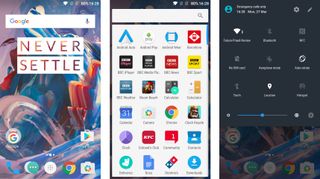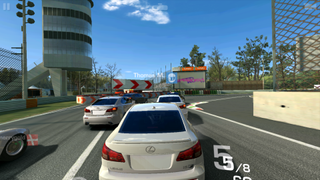Why you can trust TechRadar
The OnePlus 3T may not have a flagship price tag, but when it comes to performance and power it’s up there with the best of them.
One of the main upgrades in the OnePlus 3T is on-screen performance, with the Chinese firm claiming it’s faster than the Galaxy S7 and iPhone 7 thanks to the new chipset stuffed inside.
Other than that though, everything is pretty much the same as six months ago on the OnePlus 3 – which again, isn’t a bad thing.
Interface and reliability
- Android 6.0.1 with Oxygen OS interface providing additional functionality
- Update to Android Oreo has arrived
The OnePlus 3T launched with Android 6.0.1 Marshmallow, which was a little disappointing with Android 7 Nougat available – but don’t fear as OnePlus has pushed out the update to Google's latest software.
And the company isn't stopping there, as it's now rolling Android Oreo out to the phone, though this will be the last major update the 3T gets.
It’s not quite stock Android on the 3T, with OnePlus’ own Oxygen OS running over the top of Google’s software, giving you additional features and customization options.
Day-to-day, though, it’s very much Android, with a clear, fuss-free interface. Swipe down from the top of the display and the notification panel offers a range of editable quick settings and a screen brightness slider.

Tap the app drawer icon in the dock at the bottom of the display and you’ll find a vertically scrolling list of all your installed applications – of which very few come preinstalled.
Other than the stock apps and Google’s suite, OnePlus has ensured the 3T is kept lean, allowing you to put your own stamp on your phone via the Play Store.
The update to Android Oreo though has added a few new features, such as picture-in-picture and a 'Parallel Apps' feature, which lets you clone apps such as Facebook so you can log in to them with more than one account.
While on paper the OnePlus 3T and 3 have the same software, the newer handset does have a few subtle changes.
There’s a new wallpaper, the 'clear all' button in the multi-tasking menu is bigger, circular and centralized, and the screen brightness slider in the notification bar now has a toggle for auto-brightness.
The interface is easy to navigate, and flows well between menus and screens with no sign of lag.
Music, movies and gaming
- 3.5mm headphone jack means you can use wired headphones
- 128GB model gives you more space (there’s no microSD support)
With a heap of power under the hood, a full HD AMOLED display, a larger 128GB storage option and a headphone jack, the OnePlus 3T comes well equipped for music, movies and gaming.
The main preinstalled media apps are Google’s offerings, with Play Music enabling you to access your own songs that you've transferred onto the OnePlus 3T, as well as giving you the option to use the firm’s own pay-monthly streaming service.
Yet OnePlus has seen fit to include its own, simpler music player app as well – as it did on the OnePlus 3 – giving you a cleaner, fuss-free offering if you so wish.

Both options are perfectly serviceable – and connect a set of headphones to the OnePlus 3T and the sound output is more than reasonable.
The built-in speaker on the base of the OnePlus 3T kicks out a decent volume, with the ability to fill a room for casual listening (or watching the latest YouTube craze) in relative comfort; just don’t expect solid bass or exceptional clarity.
Video playback is also great on the OnePlus 3T, with the Full HD display providing clear visuals and bright colors – although it doesn’t have quite the same clarity as the QHD resolution displays of the Galaxy S7 Edge, HTC 10 and LG G5.
The file explorer app is a handy addition when it comes to easily locating video files transferred onto the handset, while Google’s Play Movies application gives you access to a wide range of films and TV shows to rent and buy.

Gaming is another highly enjoyable feature of the OnePlus 3T, with the punchier chipset providing faster load times and smoother gameplay. The phone also doesn’t get too hot during extending periods of play, making it comfortable to hold during epic battles and races.
Performance and benchmarks
- Quick app load times and multi-tasking
- Faster performance over the OnePlus 3
The OnePlus 3T sports Qualcomm's Snapdragon 821 chipset – that’s the same chip you’ll find in the Google Pixel and Pixel XL – and with 6GB of RAM providing ample support this is a serious power player.
OnePlus reckons the 3T can topple the Galaxy S7 and iPhone 7 in terms of speed, with the new chipset coupled with a new file system making everything slicker than on the OnePlus 3.
Running the Geekbench 4 CPU benchmark on the Android 6 software, the OnePlus 3T managed an average multi-core score of 4,313, putting it above the Sony Xperia X and Google Pixel XL.
However, running the same test after upgrading the OnePlus 3T to Android 7 Nougat and the results are quite so impressive. It now averages 3,894, which is still a strong showing, but it brings it much closer in line with its predecessor.

Performing the same benchmark on the OnePlus 3, running Android 6 and connected to the same Wi-Fi network, we achieved a multi-core score of 3,898.
What does that mean for day-to-day use? A super-slick smartphone, with apps loading promptly and effortless multi-tasking as you jump between different applications.
Load times for games such as Real Racing 3, Boom Beach and Animation Throwdown are improved over the OnePlus 3, and it feels like the 3T is a top flagship phone.
And it's all the more impressive when you remember the price. In short, you can throw anything at the OnePlus 3T and it’ll gobble it up with ease.
See how the OnePlus 3T compares to the iPhone 7 in our high intensity speed test.
Current page: What’s it like to use?
Prev Page Introduction, design and display Next Page Battery life and camera
John joined TechRadar over a decade ago as Staff Writer for Phones, and over the years has built up a vast knowledge of the tech industry. He's interviewed CEOs from some of the world's biggest tech firms, visited their HQs and has appeared on live TV and radio, including Sky News, BBC News, BBC World News, Al Jazeera, LBC and BBC Radio 4. Originally specializing in phones, tablets and wearables, John is now TechRadar's resident automotive expert, reviewing the latest and greatest EVs and PHEVs on the market. John also looks after the day-to-day running of the site.

Record Store Day 2024 – the full list, plus five essential albums to pick up

Obscure $10 billion chip firm you never heard of finally delivers crucial tech for AI future — Astera Labs showcased its Aries 6 PCIe retimer board as it targets future Nvidia HGX boards

Quordle today – hints and answers for Saturday, April 20 (game #817)
